Assignment on Strengths Based Leadership
VerifiedAdded on 2022/08/18
|13
|3275
|12
AI Summary
Contribute Materials
Your contribution can guide someone’s learning journey. Share your
documents today.
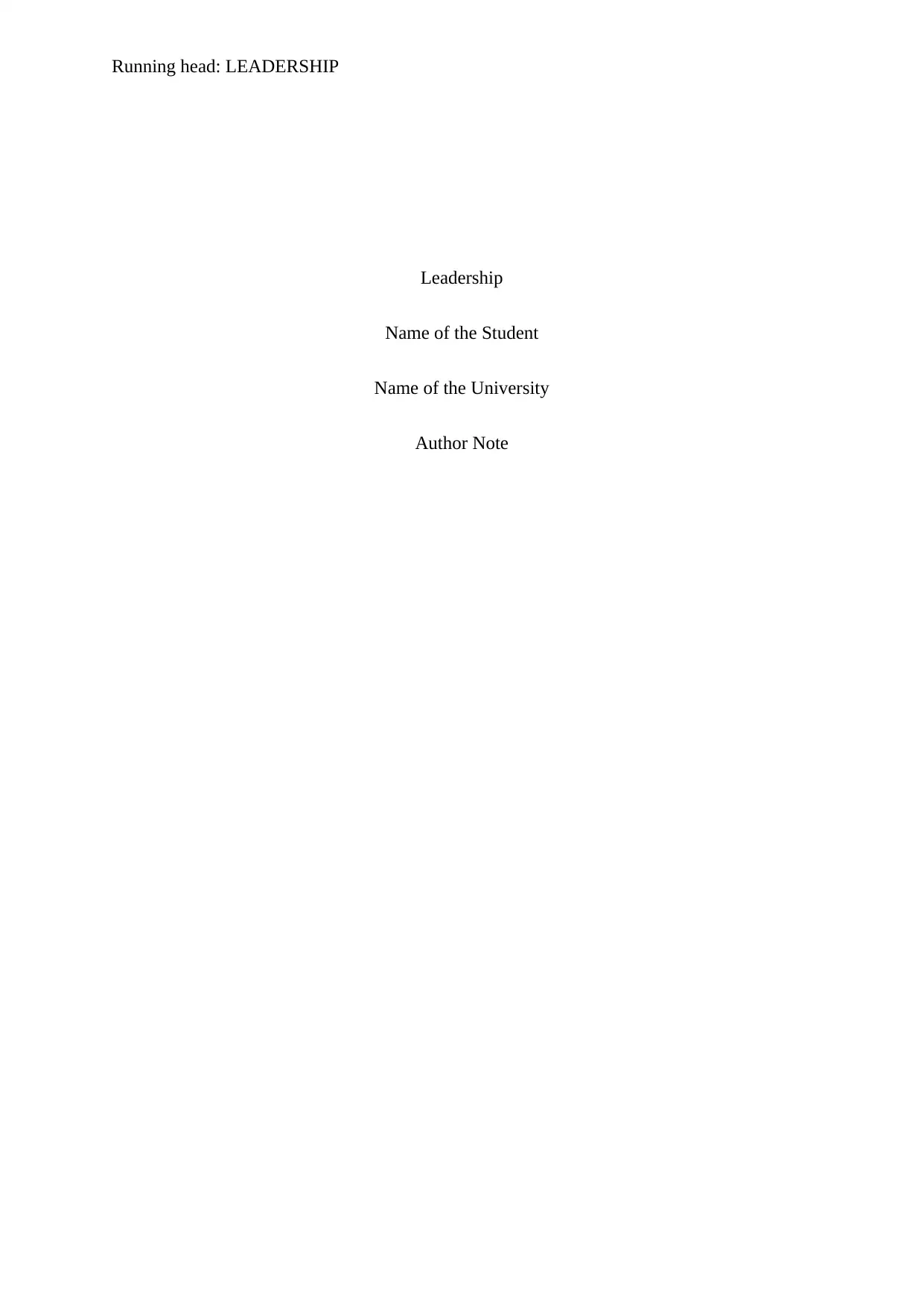
Running head: LEADERSHIP
Leadership
Name of the Student
Name of the University
Author Note
Leadership
Name of the Student
Name of the University
Author Note
Secure Best Marks with AI Grader
Need help grading? Try our AI Grader for instant feedback on your assignments.
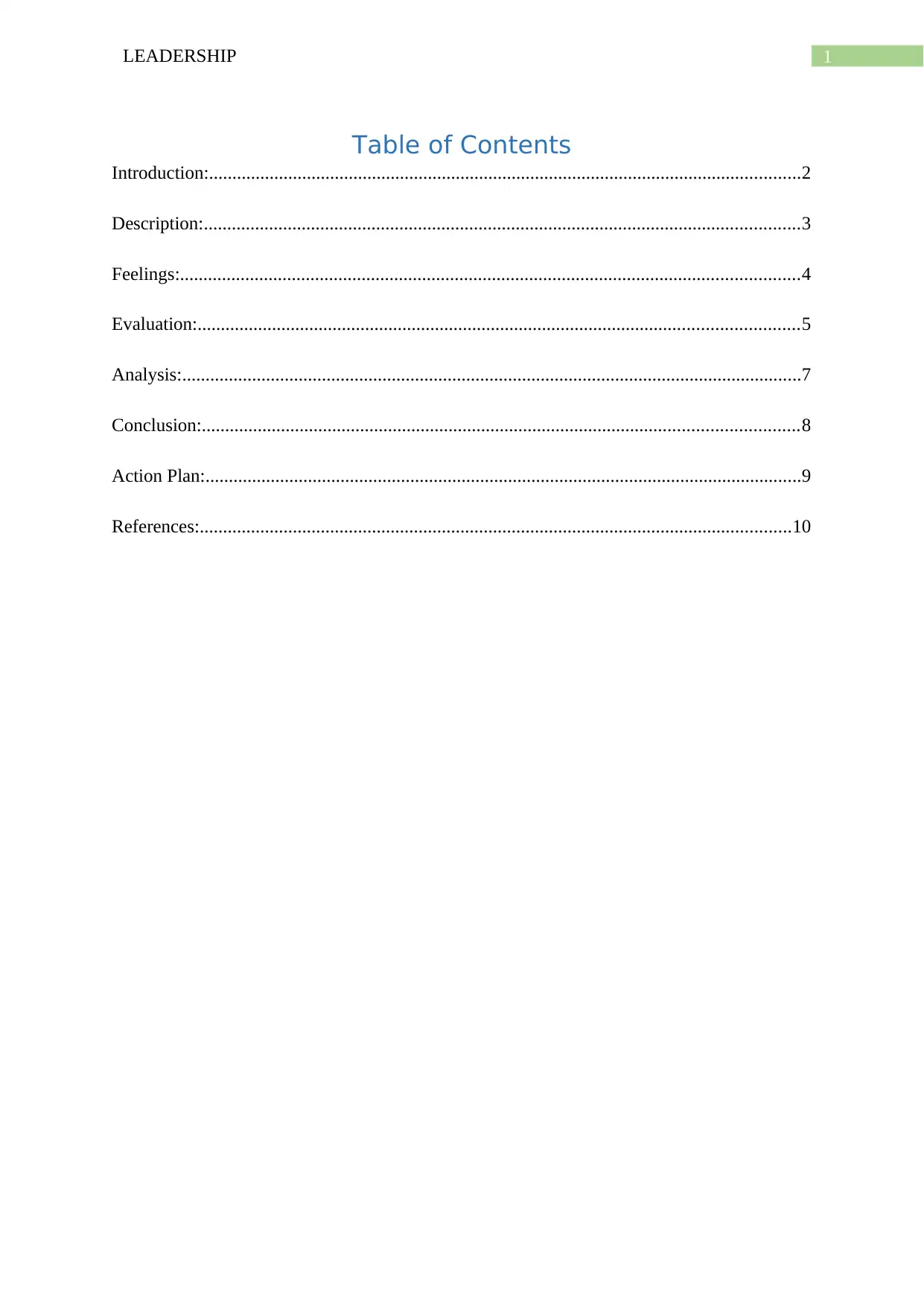
1LEADERSHIP
Table of Contents
Introduction:...............................................................................................................................2
Description:................................................................................................................................3
Feelings:.....................................................................................................................................4
Evaluation:.................................................................................................................................5
Analysis:.....................................................................................................................................7
Conclusion:................................................................................................................................8
Action Plan:................................................................................................................................9
References:...............................................................................................................................10
Table of Contents
Introduction:...............................................................................................................................2
Description:................................................................................................................................3
Feelings:.....................................................................................................................................4
Evaluation:.................................................................................................................................5
Analysis:.....................................................................................................................................7
Conclusion:................................................................................................................................8
Action Plan:................................................................................................................................9
References:...............................................................................................................................10
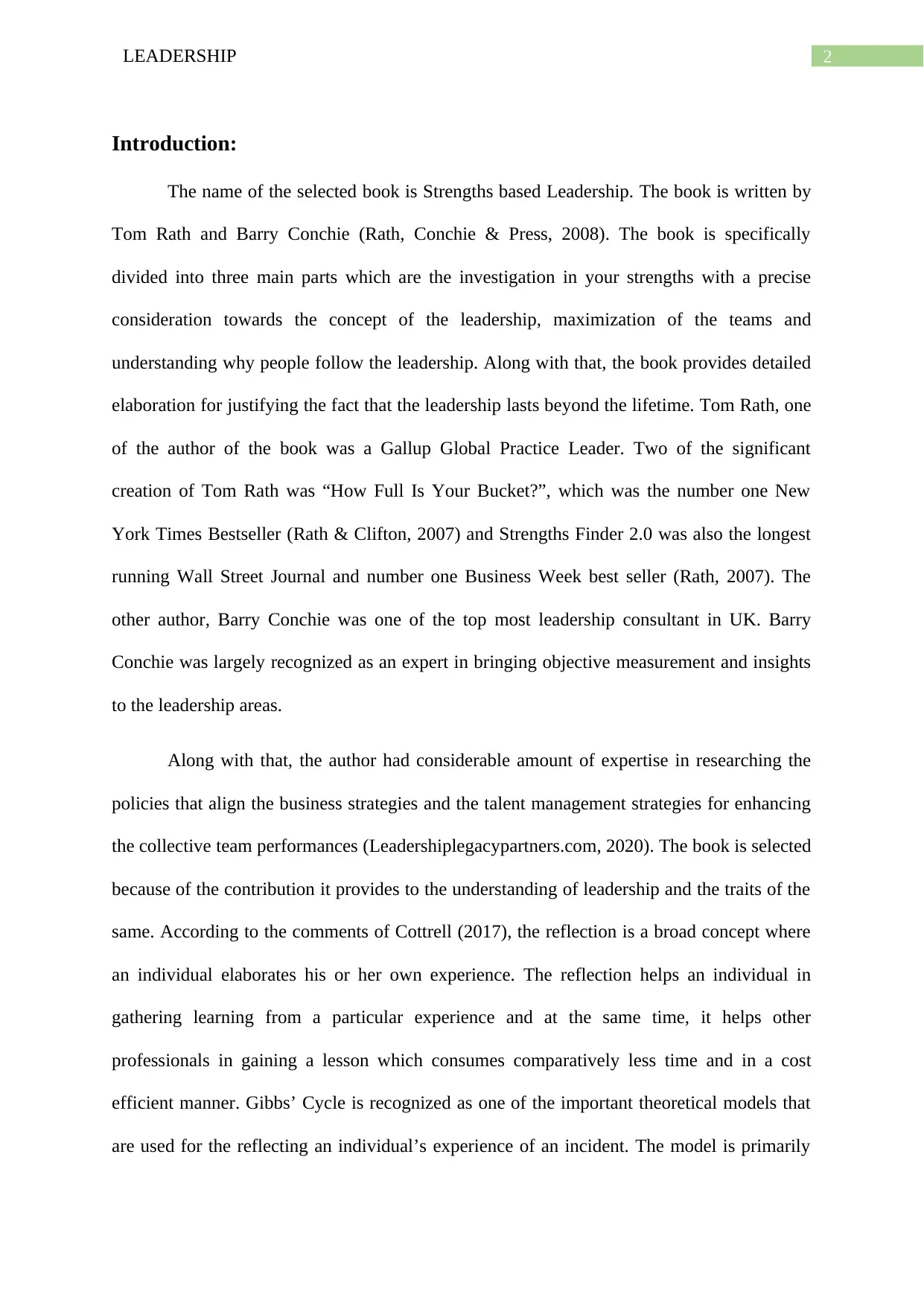
2LEADERSHIP
Introduction:
The name of the selected book is Strengths based Leadership. The book is written by
Tom Rath and Barry Conchie (Rath, Conchie & Press, 2008). The book is specifically
divided into three main parts which are the investigation in your strengths with a precise
consideration towards the concept of the leadership, maximization of the teams and
understanding why people follow the leadership. Along with that, the book provides detailed
elaboration for justifying the fact that the leadership lasts beyond the lifetime. Tom Rath, one
of the author of the book was a Gallup Global Practice Leader. Two of the significant
creation of Tom Rath was “How Full Is Your Bucket?”, which was the number one New
York Times Bestseller (Rath & Clifton, 2007) and Strengths Finder 2.0 was also the longest
running Wall Street Journal and number one Business Week best seller (Rath, 2007). The
other author, Barry Conchie was one of the top most leadership consultant in UK. Barry
Conchie was largely recognized as an expert in bringing objective measurement and insights
to the leadership areas.
Along with that, the author had considerable amount of expertise in researching the
policies that align the business strategies and the talent management strategies for enhancing
the collective team performances (Leadershiplegacypartners.com, 2020). The book is selected
because of the contribution it provides to the understanding of leadership and the traits of the
same. According to the comments of Cottrell (2017), the reflection is a broad concept where
an individual elaborates his or her own experience. The reflection helps an individual in
gathering learning from a particular experience and at the same time, it helps other
professionals in gaining a lesson which consumes comparatively less time and in a cost
efficient manner. Gibbs’ Cycle is recognized as one of the important theoretical models that
are used for the reflecting an individual’s experience of an incident. The model is primarily
Introduction:
The name of the selected book is Strengths based Leadership. The book is written by
Tom Rath and Barry Conchie (Rath, Conchie & Press, 2008). The book is specifically
divided into three main parts which are the investigation in your strengths with a precise
consideration towards the concept of the leadership, maximization of the teams and
understanding why people follow the leadership. Along with that, the book provides detailed
elaboration for justifying the fact that the leadership lasts beyond the lifetime. Tom Rath, one
of the author of the book was a Gallup Global Practice Leader. Two of the significant
creation of Tom Rath was “How Full Is Your Bucket?”, which was the number one New
York Times Bestseller (Rath & Clifton, 2007) and Strengths Finder 2.0 was also the longest
running Wall Street Journal and number one Business Week best seller (Rath, 2007). The
other author, Barry Conchie was one of the top most leadership consultant in UK. Barry
Conchie was largely recognized as an expert in bringing objective measurement and insights
to the leadership areas.
Along with that, the author had considerable amount of expertise in researching the
policies that align the business strategies and the talent management strategies for enhancing
the collective team performances (Leadershiplegacypartners.com, 2020). The book is selected
because of the contribution it provides to the understanding of leadership and the traits of the
same. According to the comments of Cottrell (2017), the reflection is a broad concept where
an individual elaborates his or her own experience. The reflection helps an individual in
gathering learning from a particular experience and at the same time, it helps other
professionals in gaining a lesson which consumes comparatively less time and in a cost
efficient manner. Gibbs’ Cycle is recognized as one of the important theoretical models that
are used for the reflecting an individual’s experience of an incident. The model is primarily
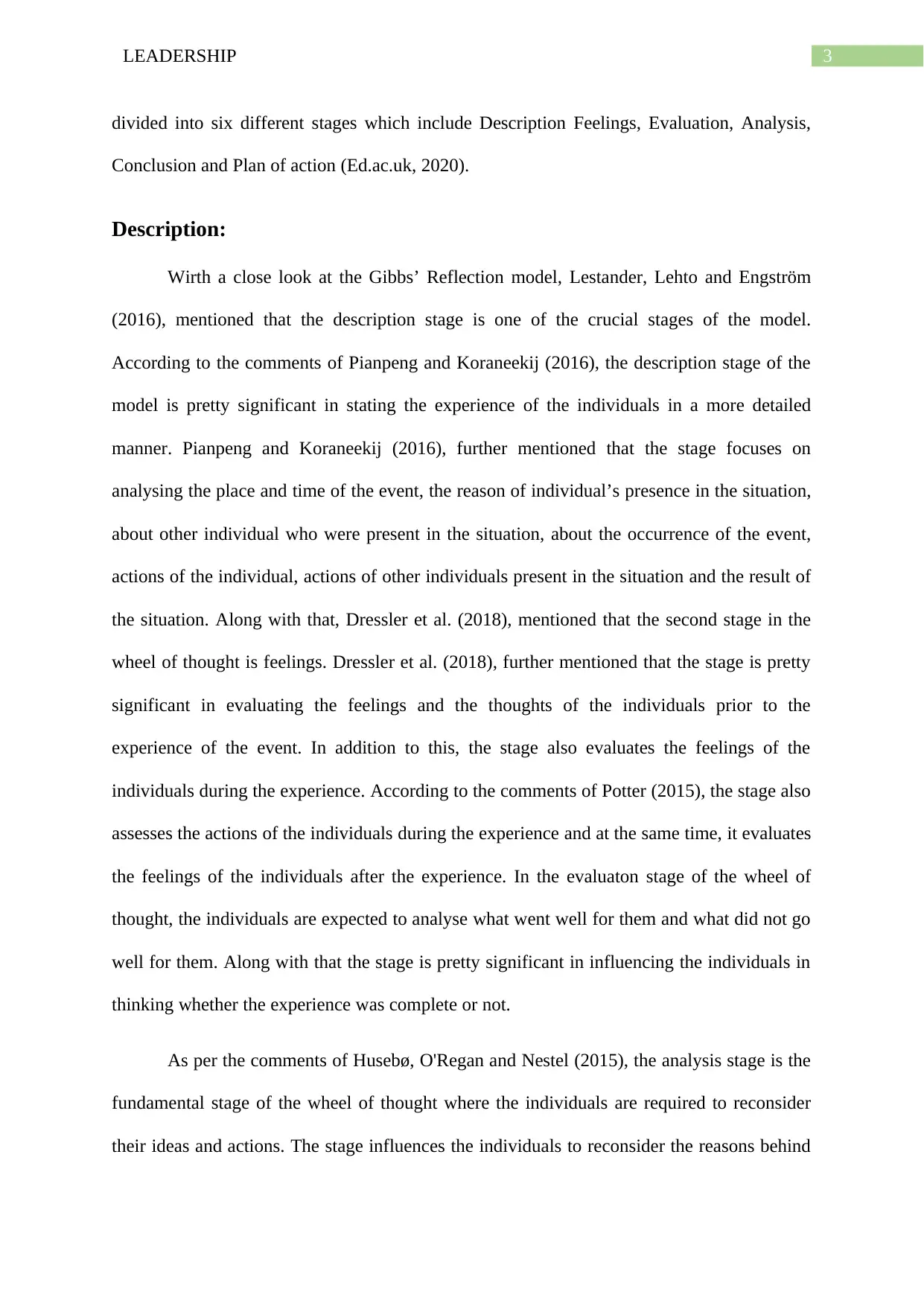
3LEADERSHIP
divided into six different stages which include Description Feelings, Evaluation, Analysis,
Conclusion and Plan of action (Ed.ac.uk, 2020).
Description:
Wirth a close look at the Gibbs’ Reflection model, Lestander, Lehto and Engström
(2016), mentioned that the description stage is one of the crucial stages of the model.
According to the comments of Pianpeng and Koraneekij (2016), the description stage of the
model is pretty significant in stating the experience of the individuals in a more detailed
manner. Pianpeng and Koraneekij (2016), further mentioned that the stage focuses on
analysing the place and time of the event, the reason of individual’s presence in the situation,
about other individual who were present in the situation, about the occurrence of the event,
actions of the individual, actions of other individuals present in the situation and the result of
the situation. Along with that, Dressler et al. (2018), mentioned that the second stage in the
wheel of thought is feelings. Dressler et al. (2018), further mentioned that the stage is pretty
significant in evaluating the feelings and the thoughts of the individuals prior to the
experience of the event. In addition to this, the stage also evaluates the feelings of the
individuals during the experience. According to the comments of Potter (2015), the stage also
assesses the actions of the individuals during the experience and at the same time, it evaluates
the feelings of the individuals after the experience. In the evaluaton stage of the wheel of
thought, the individuals are expected to analyse what went well for them and what did not go
well for them. Along with that the stage is pretty significant in influencing the individuals in
thinking whether the experience was complete or not.
As per the comments of Husebø, O'Regan and Nestel (2015), the analysis stage is the
fundamental stage of the wheel of thought where the individuals are required to reconsider
their ideas and actions. The stage influences the individuals to reconsider the reasons behind
divided into six different stages which include Description Feelings, Evaluation, Analysis,
Conclusion and Plan of action (Ed.ac.uk, 2020).
Description:
Wirth a close look at the Gibbs’ Reflection model, Lestander, Lehto and Engström
(2016), mentioned that the description stage is one of the crucial stages of the model.
According to the comments of Pianpeng and Koraneekij (2016), the description stage of the
model is pretty significant in stating the experience of the individuals in a more detailed
manner. Pianpeng and Koraneekij (2016), further mentioned that the stage focuses on
analysing the place and time of the event, the reason of individual’s presence in the situation,
about other individual who were present in the situation, about the occurrence of the event,
actions of the individual, actions of other individuals present in the situation and the result of
the situation. Along with that, Dressler et al. (2018), mentioned that the second stage in the
wheel of thought is feelings. Dressler et al. (2018), further mentioned that the stage is pretty
significant in evaluating the feelings and the thoughts of the individuals prior to the
experience of the event. In addition to this, the stage also evaluates the feelings of the
individuals during the experience. According to the comments of Potter (2015), the stage also
assesses the actions of the individuals during the experience and at the same time, it evaluates
the feelings of the individuals after the experience. In the evaluaton stage of the wheel of
thought, the individuals are expected to analyse what went well for them and what did not go
well for them. Along with that the stage is pretty significant in influencing the individuals in
thinking whether the experience was complete or not.
As per the comments of Husebø, O'Regan and Nestel (2015), the analysis stage is the
fundamental stage of the wheel of thought where the individuals are required to reconsider
their ideas and actions. The stage influences the individuals to reconsider the reasons behind
Secure Best Marks with AI Grader
Need help grading? Try our AI Grader for instant feedback on your assignments.
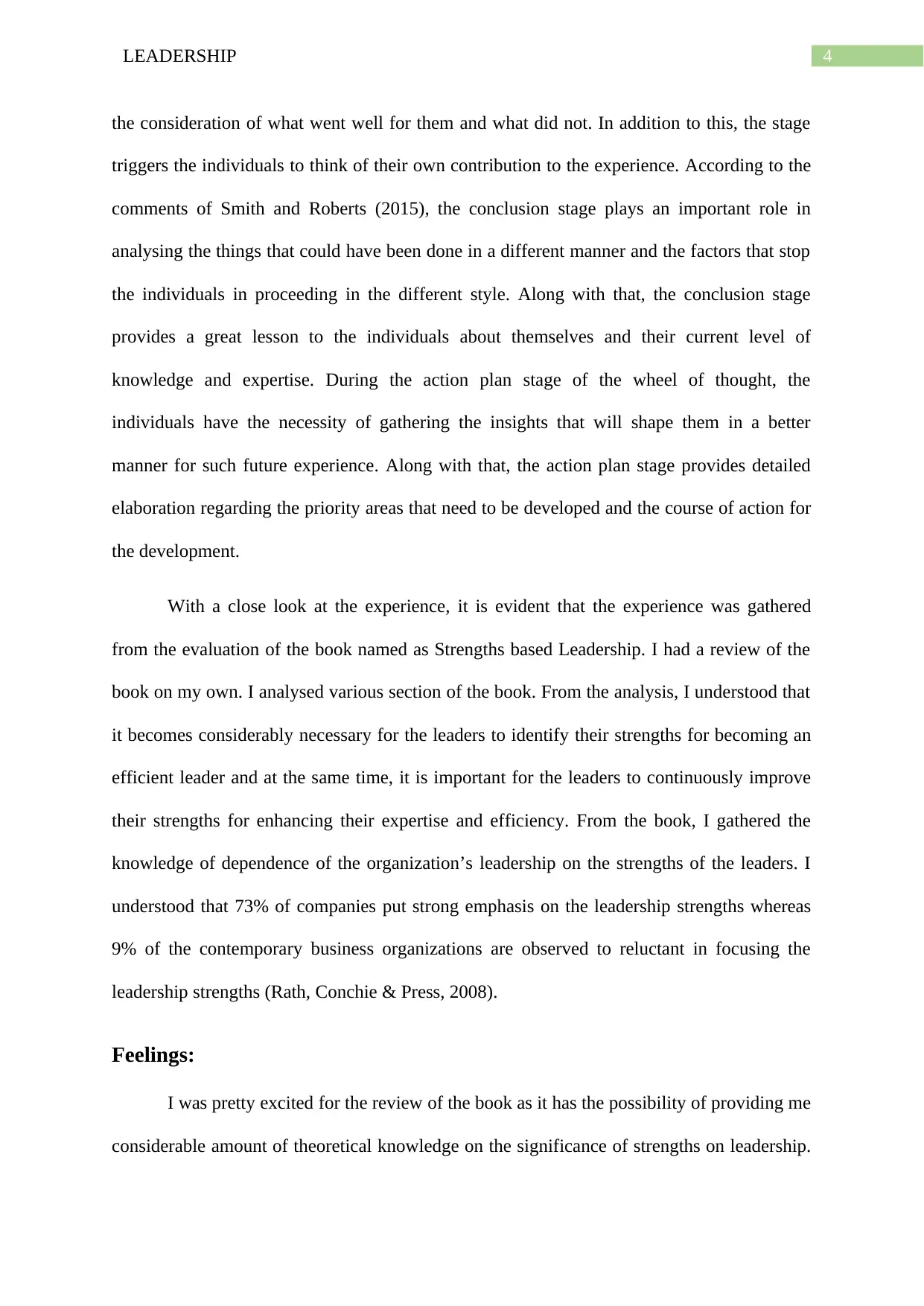
4LEADERSHIP
the consideration of what went well for them and what did not. In addition to this, the stage
triggers the individuals to think of their own contribution to the experience. According to the
comments of Smith and Roberts (2015), the conclusion stage plays an important role in
analysing the things that could have been done in a different manner and the factors that stop
the individuals in proceeding in the different style. Along with that, the conclusion stage
provides a great lesson to the individuals about themselves and their current level of
knowledge and expertise. During the action plan stage of the wheel of thought, the
individuals have the necessity of gathering the insights that will shape them in a better
manner for such future experience. Along with that, the action plan stage provides detailed
elaboration regarding the priority areas that need to be developed and the course of action for
the development.
With a close look at the experience, it is evident that the experience was gathered
from the evaluation of the book named as Strengths based Leadership. I had a review of the
book on my own. I analysed various section of the book. From the analysis, I understood that
it becomes considerably necessary for the leaders to identify their strengths for becoming an
efficient leader and at the same time, it is important for the leaders to continuously improve
their strengths for enhancing their expertise and efficiency. From the book, I gathered the
knowledge of dependence of the organization’s leadership on the strengths of the leaders. I
understood that 73% of companies put strong emphasis on the leadership strengths whereas
9% of the contemporary business organizations are observed to reluctant in focusing the
leadership strengths (Rath, Conchie & Press, 2008).
Feelings:
I was pretty excited for the review of the book as it has the possibility of providing me
considerable amount of theoretical knowledge on the significance of strengths on leadership.
the consideration of what went well for them and what did not. In addition to this, the stage
triggers the individuals to think of their own contribution to the experience. According to the
comments of Smith and Roberts (2015), the conclusion stage plays an important role in
analysing the things that could have been done in a different manner and the factors that stop
the individuals in proceeding in the different style. Along with that, the conclusion stage
provides a great lesson to the individuals about themselves and their current level of
knowledge and expertise. During the action plan stage of the wheel of thought, the
individuals have the necessity of gathering the insights that will shape them in a better
manner for such future experience. Along with that, the action plan stage provides detailed
elaboration regarding the priority areas that need to be developed and the course of action for
the development.
With a close look at the experience, it is evident that the experience was gathered
from the evaluation of the book named as Strengths based Leadership. I had a review of the
book on my own. I analysed various section of the book. From the analysis, I understood that
it becomes considerably necessary for the leaders to identify their strengths for becoming an
efficient leader and at the same time, it is important for the leaders to continuously improve
their strengths for enhancing their expertise and efficiency. From the book, I gathered the
knowledge of dependence of the organization’s leadership on the strengths of the leaders. I
understood that 73% of companies put strong emphasis on the leadership strengths whereas
9% of the contemporary business organizations are observed to reluctant in focusing the
leadership strengths (Rath, Conchie & Press, 2008).
Feelings:
I was pretty excited for the review of the book as it has the possibility of providing me
considerable amount of theoretical knowledge on the significance of strengths on leadership.
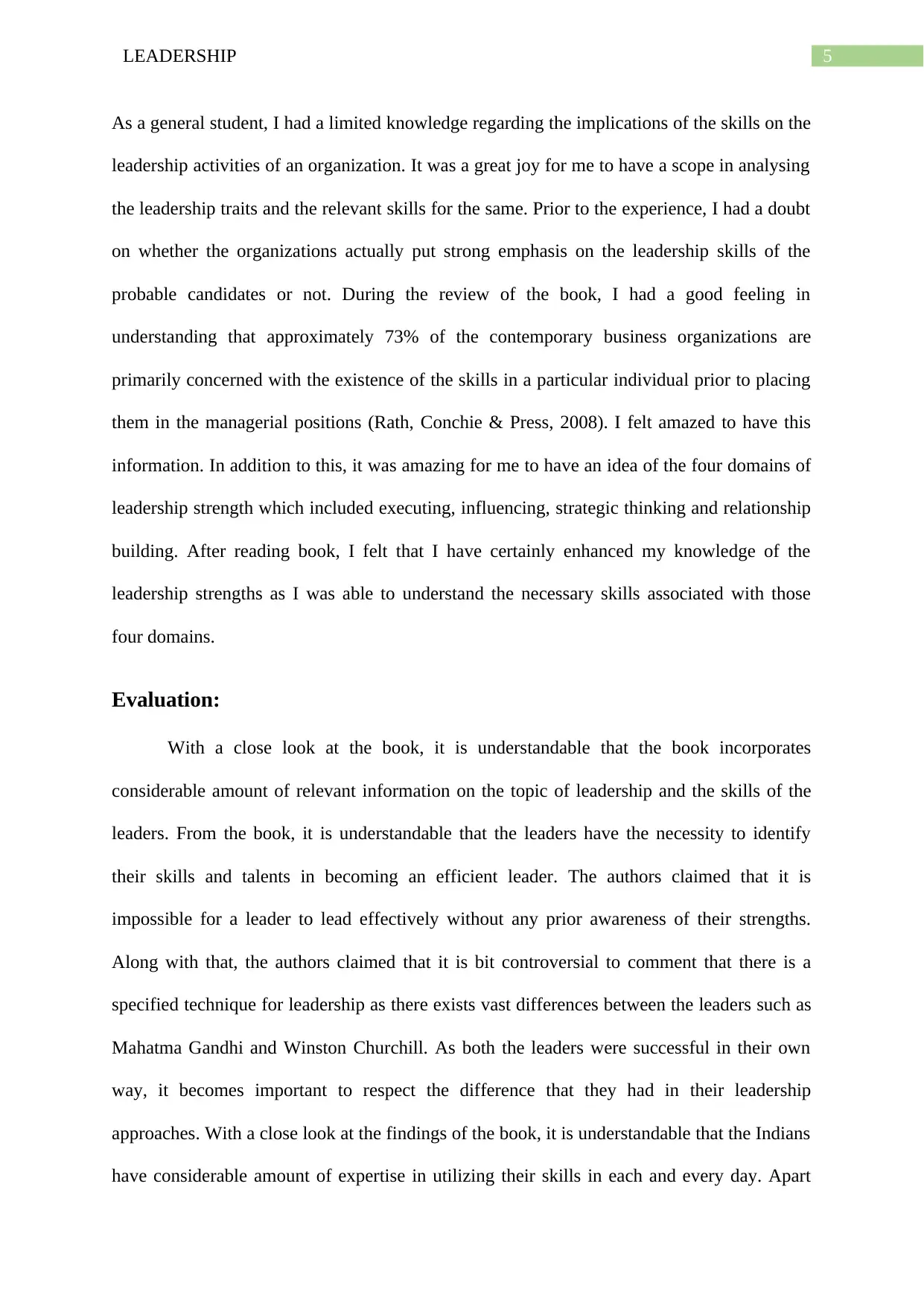
5LEADERSHIP
As a general student, I had a limited knowledge regarding the implications of the skills on the
leadership activities of an organization. It was a great joy for me to have a scope in analysing
the leadership traits and the relevant skills for the same. Prior to the experience, I had a doubt
on whether the organizations actually put strong emphasis on the leadership skills of the
probable candidates or not. During the review of the book, I had a good feeling in
understanding that approximately 73% of the contemporary business organizations are
primarily concerned with the existence of the skills in a particular individual prior to placing
them in the managerial positions (Rath, Conchie & Press, 2008). I felt amazed to have this
information. In addition to this, it was amazing for me to have an idea of the four domains of
leadership strength which included executing, influencing, strategic thinking and relationship
building. After reading book, I felt that I have certainly enhanced my knowledge of the
leadership strengths as I was able to understand the necessary skills associated with those
four domains.
Evaluation:
With a close look at the book, it is understandable that the book incorporates
considerable amount of relevant information on the topic of leadership and the skills of the
leaders. From the book, it is understandable that the leaders have the necessity to identify
their skills and talents in becoming an efficient leader. The authors claimed that it is
impossible for a leader to lead effectively without any prior awareness of their strengths.
Along with that, the authors claimed that it is bit controversial to comment that there is a
specified technique for leadership as there exists vast differences between the leaders such as
Mahatma Gandhi and Winston Churchill. As both the leaders were successful in their own
way, it becomes important to respect the difference that they had in their leadership
approaches. With a close look at the findings of the book, it is understandable that the Indians
have considerable amount of expertise in utilizing their skills in each and every day. Apart
As a general student, I had a limited knowledge regarding the implications of the skills on the
leadership activities of an organization. It was a great joy for me to have a scope in analysing
the leadership traits and the relevant skills for the same. Prior to the experience, I had a doubt
on whether the organizations actually put strong emphasis on the leadership skills of the
probable candidates or not. During the review of the book, I had a good feeling in
understanding that approximately 73% of the contemporary business organizations are
primarily concerned with the existence of the skills in a particular individual prior to placing
them in the managerial positions (Rath, Conchie & Press, 2008). I felt amazed to have this
information. In addition to this, it was amazing for me to have an idea of the four domains of
leadership strength which included executing, influencing, strategic thinking and relationship
building. After reading book, I felt that I have certainly enhanced my knowledge of the
leadership strengths as I was able to understand the necessary skills associated with those
four domains.
Evaluation:
With a close look at the book, it is understandable that the book incorporates
considerable amount of relevant information on the topic of leadership and the skills of the
leaders. From the book, it is understandable that the leaders have the necessity to identify
their skills and talents in becoming an efficient leader. The authors claimed that it is
impossible for a leader to lead effectively without any prior awareness of their strengths.
Along with that, the authors claimed that it is bit controversial to comment that there is a
specified technique for leadership as there exists vast differences between the leaders such as
Mahatma Gandhi and Winston Churchill. As both the leaders were successful in their own
way, it becomes important to respect the difference that they had in their leadership
approaches. With a close look at the findings of the book, it is understandable that the Indians
have considerable amount of expertise in utilizing their skills in each and every day. Apart
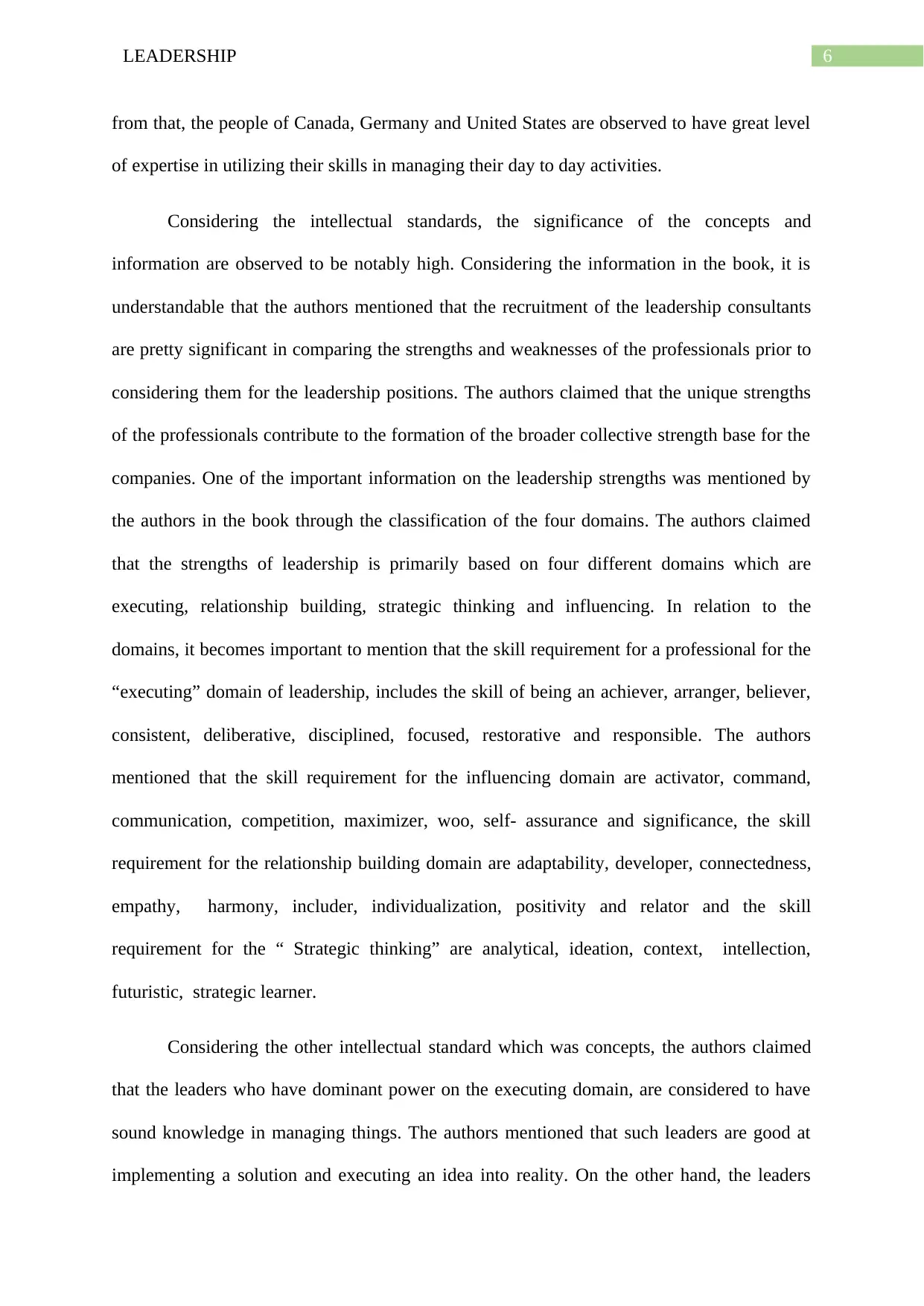
6LEADERSHIP
from that, the people of Canada, Germany and United States are observed to have great level
of expertise in utilizing their skills in managing their day to day activities.
Considering the intellectual standards, the significance of the concepts and
information are observed to be notably high. Considering the information in the book, it is
understandable that the authors mentioned that the recruitment of the leadership consultants
are pretty significant in comparing the strengths and weaknesses of the professionals prior to
considering them for the leadership positions. The authors claimed that the unique strengths
of the professionals contribute to the formation of the broader collective strength base for the
companies. One of the important information on the leadership strengths was mentioned by
the authors in the book through the classification of the four domains. The authors claimed
that the strengths of leadership is primarily based on four different domains which are
executing, relationship building, strategic thinking and influencing. In relation to the
domains, it becomes important to mention that the skill requirement for a professional for the
“executing” domain of leadership, includes the skill of being an achiever, arranger, believer,
consistent, deliberative, disciplined, focused, restorative and responsible. The authors
mentioned that the skill requirement for the influencing domain are activator, command,
communication, competition, maximizer, woo, self- assurance and significance, the skill
requirement for the relationship building domain are adaptability, developer, connectedness,
empathy, harmony, includer, individualization, positivity and relator and the skill
requirement for the “ Strategic thinking” are analytical, ideation, context, intellection,
futuristic, strategic learner.
Considering the other intellectual standard which was concepts, the authors claimed
that the leaders who have dominant power on the executing domain, are considered to have
sound knowledge in managing things. The authors mentioned that such leaders are good at
implementing a solution and executing an idea into reality. On the other hand, the leaders
from that, the people of Canada, Germany and United States are observed to have great level
of expertise in utilizing their skills in managing their day to day activities.
Considering the intellectual standards, the significance of the concepts and
information are observed to be notably high. Considering the information in the book, it is
understandable that the authors mentioned that the recruitment of the leadership consultants
are pretty significant in comparing the strengths and weaknesses of the professionals prior to
considering them for the leadership positions. The authors claimed that the unique strengths
of the professionals contribute to the formation of the broader collective strength base for the
companies. One of the important information on the leadership strengths was mentioned by
the authors in the book through the classification of the four domains. The authors claimed
that the strengths of leadership is primarily based on four different domains which are
executing, relationship building, strategic thinking and influencing. In relation to the
domains, it becomes important to mention that the skill requirement for a professional for the
“executing” domain of leadership, includes the skill of being an achiever, arranger, believer,
consistent, deliberative, disciplined, focused, restorative and responsible. The authors
mentioned that the skill requirement for the influencing domain are activator, command,
communication, competition, maximizer, woo, self- assurance and significance, the skill
requirement for the relationship building domain are adaptability, developer, connectedness,
empathy, harmony, includer, individualization, positivity and relator and the skill
requirement for the “ Strategic thinking” are analytical, ideation, context, intellection,
futuristic, strategic learner.
Considering the other intellectual standard which was concepts, the authors claimed
that the leaders who have dominant power on the executing domain, are considered to have
sound knowledge in managing things. The authors mentioned that such leaders are good at
implementing a solution and executing an idea into reality. On the other hand, the leaders
Paraphrase This Document
Need a fresh take? Get an instant paraphrase of this document with our AI Paraphraser
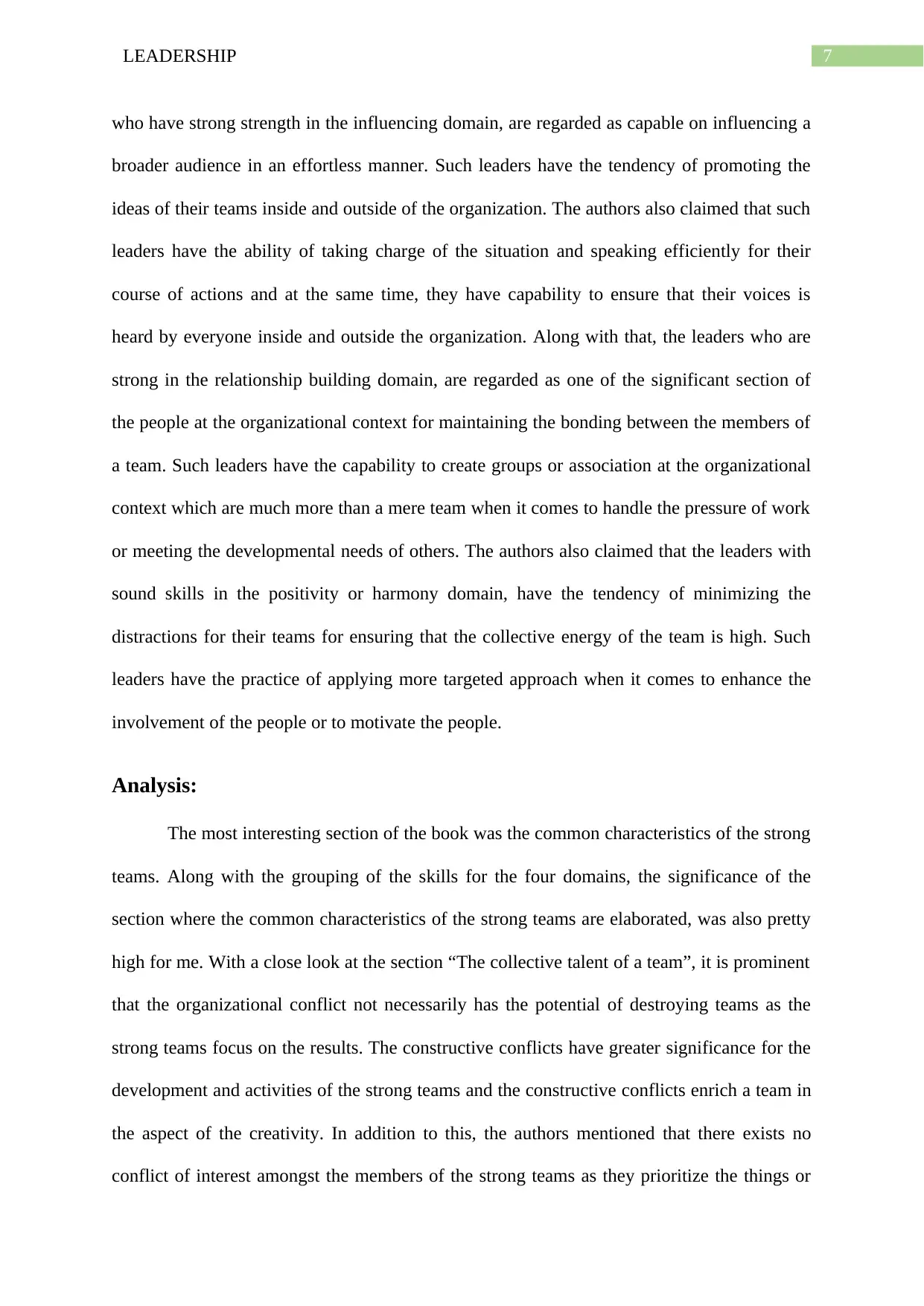
7LEADERSHIP
who have strong strength in the influencing domain, are regarded as capable on influencing a
broader audience in an effortless manner. Such leaders have the tendency of promoting the
ideas of their teams inside and outside of the organization. The authors also claimed that such
leaders have the ability of taking charge of the situation and speaking efficiently for their
course of actions and at the same time, they have capability to ensure that their voices is
heard by everyone inside and outside the organization. Along with that, the leaders who are
strong in the relationship building domain, are regarded as one of the significant section of
the people at the organizational context for maintaining the bonding between the members of
a team. Such leaders have the capability to create groups or association at the organizational
context which are much more than a mere team when it comes to handle the pressure of work
or meeting the developmental needs of others. The authors also claimed that the leaders with
sound skills in the positivity or harmony domain, have the tendency of minimizing the
distractions for their teams for ensuring that the collective energy of the team is high. Such
leaders have the practice of applying more targeted approach when it comes to enhance the
involvement of the people or to motivate the people.
Analysis:
The most interesting section of the book was the common characteristics of the strong
teams. Along with the grouping of the skills for the four domains, the significance of the
section where the common characteristics of the strong teams are elaborated, was also pretty
high for me. With a close look at the section “The collective talent of a team”, it is prominent
that the organizational conflict not necessarily has the potential of destroying teams as the
strong teams focus on the results. The constructive conflicts have greater significance for the
development and activities of the strong teams and the constructive conflicts enrich a team in
the aspect of the creativity. In addition to this, the authors mentioned that there exists no
conflict of interest amongst the members of the strong teams as they prioritize the things or
who have strong strength in the influencing domain, are regarded as capable on influencing a
broader audience in an effortless manner. Such leaders have the tendency of promoting the
ideas of their teams inside and outside of the organization. The authors also claimed that such
leaders have the ability of taking charge of the situation and speaking efficiently for their
course of actions and at the same time, they have capability to ensure that their voices is
heard by everyone inside and outside the organization. Along with that, the leaders who are
strong in the relationship building domain, are regarded as one of the significant section of
the people at the organizational context for maintaining the bonding between the members of
a team. Such leaders have the capability to create groups or association at the organizational
context which are much more than a mere team when it comes to handle the pressure of work
or meeting the developmental needs of others. The authors also claimed that the leaders with
sound skills in the positivity or harmony domain, have the tendency of minimizing the
distractions for their teams for ensuring that the collective energy of the team is high. Such
leaders have the practice of applying more targeted approach when it comes to enhance the
involvement of the people or to motivate the people.
Analysis:
The most interesting section of the book was the common characteristics of the strong
teams. Along with the grouping of the skills for the four domains, the significance of the
section where the common characteristics of the strong teams are elaborated, was also pretty
high for me. With a close look at the section “The collective talent of a team”, it is prominent
that the organizational conflict not necessarily has the potential of destroying teams as the
strong teams focus on the results. The constructive conflicts have greater significance for the
development and activities of the strong teams and the constructive conflicts enrich a team in
the aspect of the creativity. In addition to this, the authors mentioned that there exists no
conflict of interest amongst the members of the strong teams as they prioritize the things or
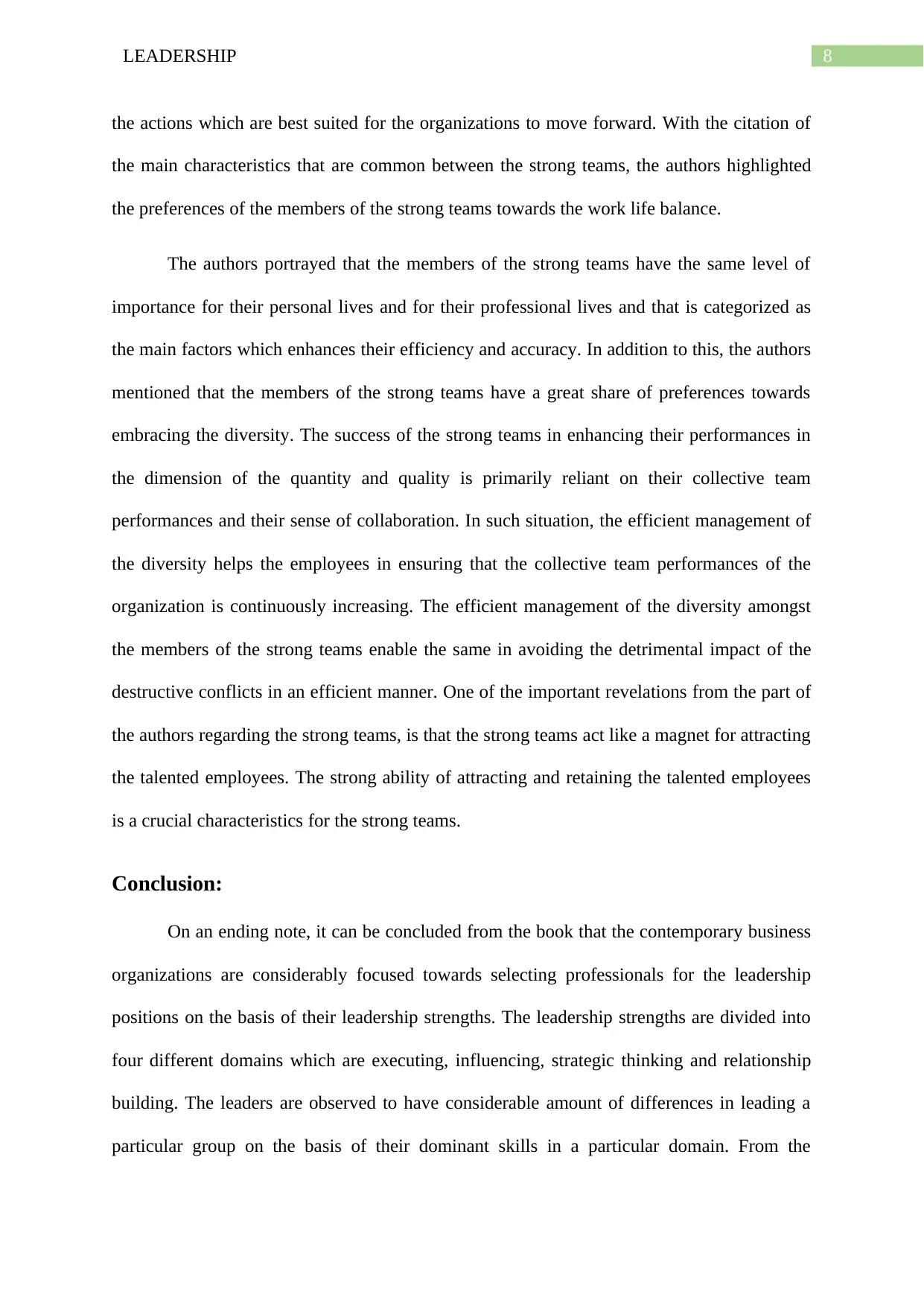
8LEADERSHIP
the actions which are best suited for the organizations to move forward. With the citation of
the main characteristics that are common between the strong teams, the authors highlighted
the preferences of the members of the strong teams towards the work life balance.
The authors portrayed that the members of the strong teams have the same level of
importance for their personal lives and for their professional lives and that is categorized as
the main factors which enhances their efficiency and accuracy. In addition to this, the authors
mentioned that the members of the strong teams have a great share of preferences towards
embracing the diversity. The success of the strong teams in enhancing their performances in
the dimension of the quantity and quality is primarily reliant on their collective team
performances and their sense of collaboration. In such situation, the efficient management of
the diversity helps the employees in ensuring that the collective team performances of the
organization is continuously increasing. The efficient management of the diversity amongst
the members of the strong teams enable the same in avoiding the detrimental impact of the
destructive conflicts in an efficient manner. One of the important revelations from the part of
the authors regarding the strong teams, is that the strong teams act like a magnet for attracting
the talented employees. The strong ability of attracting and retaining the talented employees
is a crucial characteristics for the strong teams.
Conclusion:
On an ending note, it can be concluded from the book that the contemporary business
organizations are considerably focused towards selecting professionals for the leadership
positions on the basis of their leadership strengths. The leadership strengths are divided into
four different domains which are executing, influencing, strategic thinking and relationship
building. The leaders are observed to have considerable amount of differences in leading a
particular group on the basis of their dominant skills in a particular domain. From the
the actions which are best suited for the organizations to move forward. With the citation of
the main characteristics that are common between the strong teams, the authors highlighted
the preferences of the members of the strong teams towards the work life balance.
The authors portrayed that the members of the strong teams have the same level of
importance for their personal lives and for their professional lives and that is categorized as
the main factors which enhances their efficiency and accuracy. In addition to this, the authors
mentioned that the members of the strong teams have a great share of preferences towards
embracing the diversity. The success of the strong teams in enhancing their performances in
the dimension of the quantity and quality is primarily reliant on their collective team
performances and their sense of collaboration. In such situation, the efficient management of
the diversity helps the employees in ensuring that the collective team performances of the
organization is continuously increasing. The efficient management of the diversity amongst
the members of the strong teams enable the same in avoiding the detrimental impact of the
destructive conflicts in an efficient manner. One of the important revelations from the part of
the authors regarding the strong teams, is that the strong teams act like a magnet for attracting
the talented employees. The strong ability of attracting and retaining the talented employees
is a crucial characteristics for the strong teams.
Conclusion:
On an ending note, it can be concluded from the book that the contemporary business
organizations are considerably focused towards selecting professionals for the leadership
positions on the basis of their leadership strengths. The leadership strengths are divided into
four different domains which are executing, influencing, strategic thinking and relationship
building. The leaders are observed to have considerable amount of differences in leading a
particular group on the basis of their dominant skills in a particular domain. From the
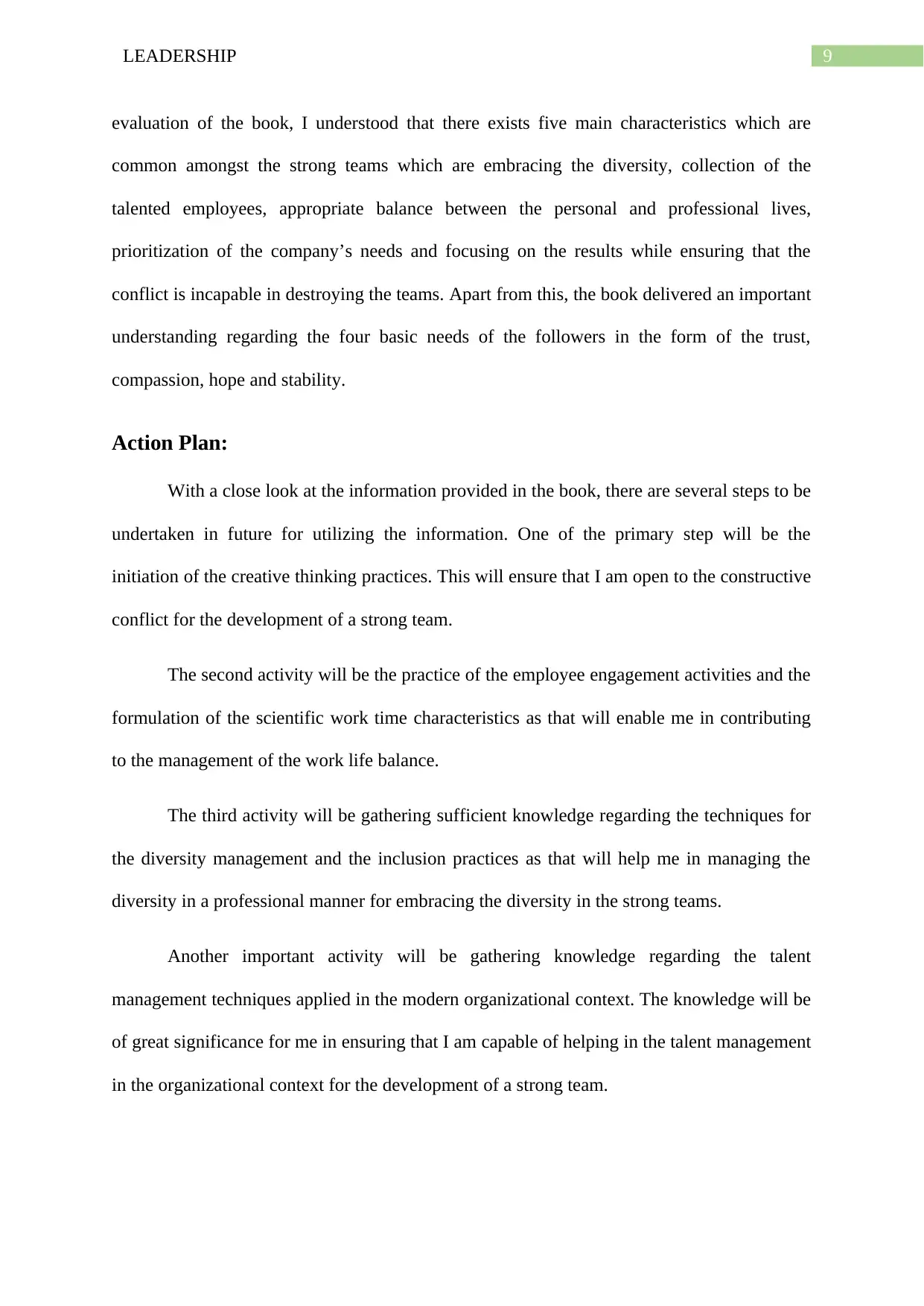
9LEADERSHIP
evaluation of the book, I understood that there exists five main characteristics which are
common amongst the strong teams which are embracing the diversity, collection of the
talented employees, appropriate balance between the personal and professional lives,
prioritization of the company’s needs and focusing on the results while ensuring that the
conflict is incapable in destroying the teams. Apart from this, the book delivered an important
understanding regarding the four basic needs of the followers in the form of the trust,
compassion, hope and stability.
Action Plan:
With a close look at the information provided in the book, there are several steps to be
undertaken in future for utilizing the information. One of the primary step will be the
initiation of the creative thinking practices. This will ensure that I am open to the constructive
conflict for the development of a strong team.
The second activity will be the practice of the employee engagement activities and the
formulation of the scientific work time characteristics as that will enable me in contributing
to the management of the work life balance.
The third activity will be gathering sufficient knowledge regarding the techniques for
the diversity management and the inclusion practices as that will help me in managing the
diversity in a professional manner for embracing the diversity in the strong teams.
Another important activity will be gathering knowledge regarding the talent
management techniques applied in the modern organizational context. The knowledge will be
of great significance for me in ensuring that I am capable of helping in the talent management
in the organizational context for the development of a strong team.
evaluation of the book, I understood that there exists five main characteristics which are
common amongst the strong teams which are embracing the diversity, collection of the
talented employees, appropriate balance between the personal and professional lives,
prioritization of the company’s needs and focusing on the results while ensuring that the
conflict is incapable in destroying the teams. Apart from this, the book delivered an important
understanding regarding the four basic needs of the followers in the form of the trust,
compassion, hope and stability.
Action Plan:
With a close look at the information provided in the book, there are several steps to be
undertaken in future for utilizing the information. One of the primary step will be the
initiation of the creative thinking practices. This will ensure that I am open to the constructive
conflict for the development of a strong team.
The second activity will be the practice of the employee engagement activities and the
formulation of the scientific work time characteristics as that will enable me in contributing
to the management of the work life balance.
The third activity will be gathering sufficient knowledge regarding the techniques for
the diversity management and the inclusion practices as that will help me in managing the
diversity in a professional manner for embracing the diversity in the strong teams.
Another important activity will be gathering knowledge regarding the talent
management techniques applied in the modern organizational context. The knowledge will be
of great significance for me in ensuring that I am capable of helping in the talent management
in the organizational context for the development of a strong team.
Secure Best Marks with AI Grader
Need help grading? Try our AI Grader for instant feedback on your assignments.
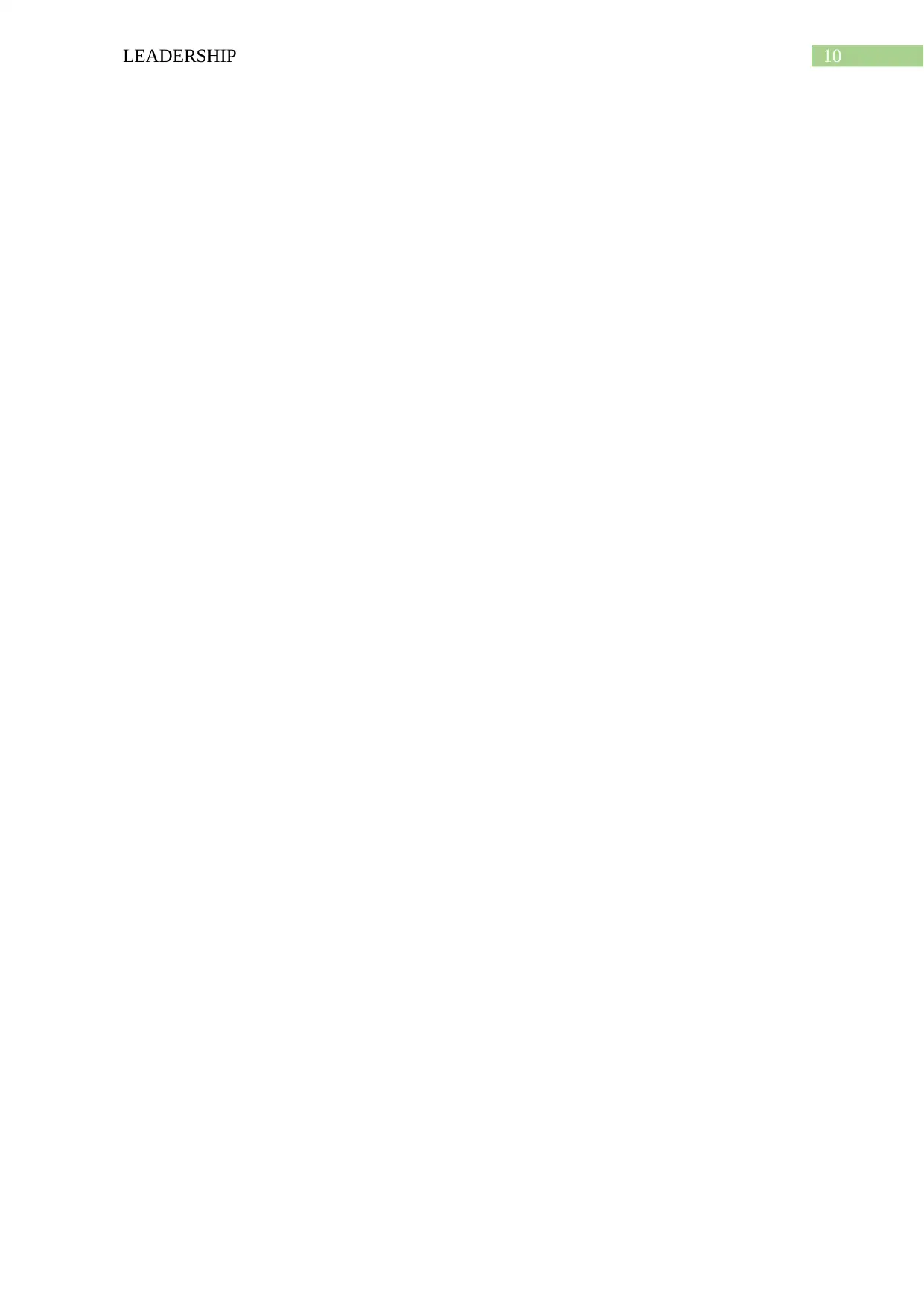
10LEADERSHIP
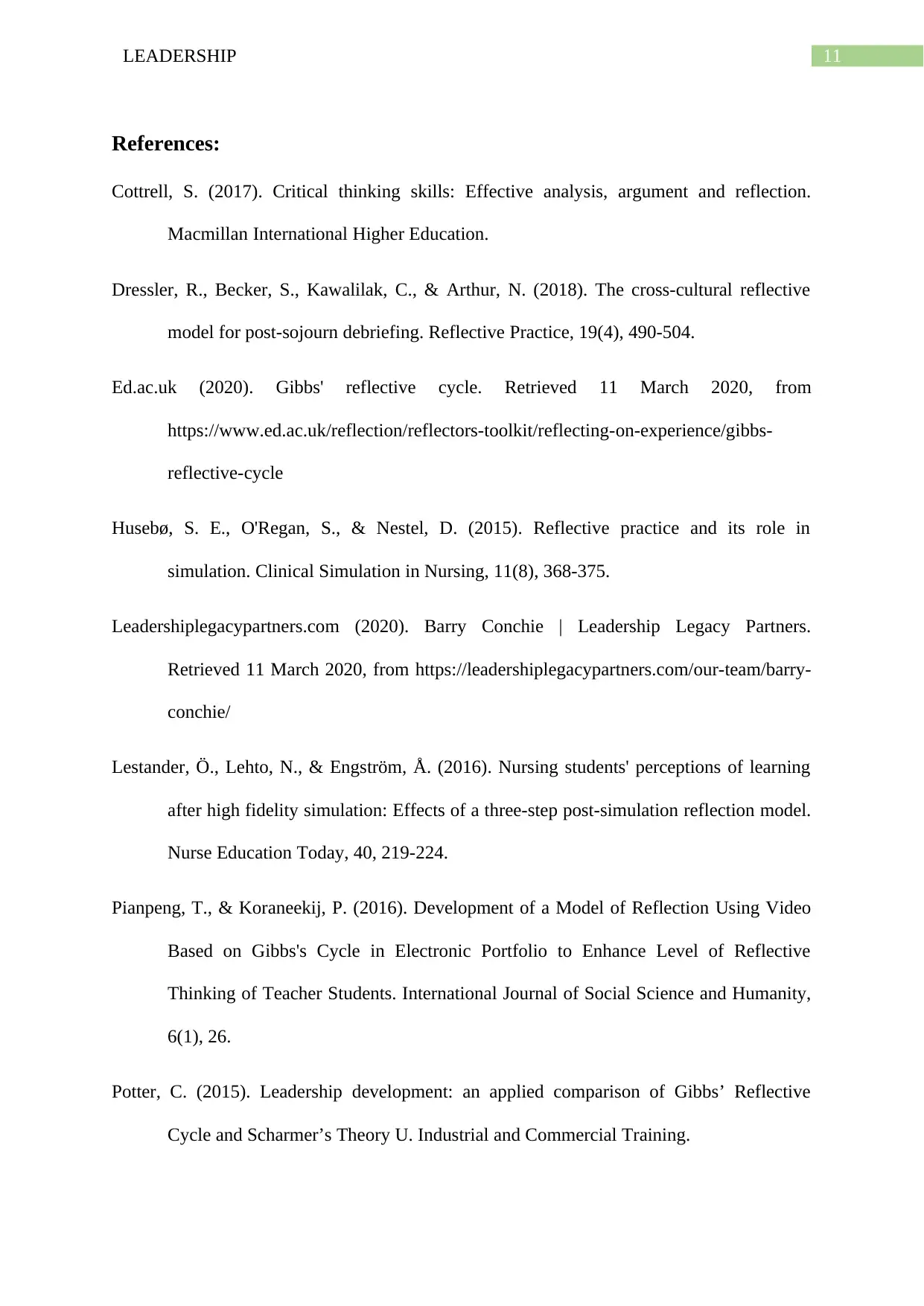
11LEADERSHIP
References:
Cottrell, S. (2017). Critical thinking skills: Effective analysis, argument and reflection.
Macmillan International Higher Education.
Dressler, R., Becker, S., Kawalilak, C., & Arthur, N. (2018). The cross-cultural reflective
model for post-sojourn debriefing. Reflective Practice, 19(4), 490-504.
Ed.ac.uk (2020). Gibbs' reflective cycle. Retrieved 11 March 2020, from
https://www.ed.ac.uk/reflection/reflectors-toolkit/reflecting-on-experience/gibbs-
reflective-cycle
Husebø, S. E., O'Regan, S., & Nestel, D. (2015). Reflective practice and its role in
simulation. Clinical Simulation in Nursing, 11(8), 368-375.
Leadershiplegacypartners.com (2020). Barry Conchie | Leadership Legacy Partners.
Retrieved 11 March 2020, from https://leadershiplegacypartners.com/our-team/barry-
conchie/
Lestander, Ö., Lehto, N., & Engström, Å. (2016). Nursing students' perceptions of learning
after high fidelity simulation: Effects of a three-step post-simulation reflection model.
Nurse Education Today, 40, 219-224.
Pianpeng, T., & Koraneekij, P. (2016). Development of a Model of Reflection Using Video
Based on Gibbs's Cycle in Electronic Portfolio to Enhance Level of Reflective
Thinking of Teacher Students. International Journal of Social Science and Humanity,
6(1), 26.
Potter, C. (2015). Leadership development: an applied comparison of Gibbs’ Reflective
Cycle and Scharmer’s Theory U. Industrial and Commercial Training.
References:
Cottrell, S. (2017). Critical thinking skills: Effective analysis, argument and reflection.
Macmillan International Higher Education.
Dressler, R., Becker, S., Kawalilak, C., & Arthur, N. (2018). The cross-cultural reflective
model for post-sojourn debriefing. Reflective Practice, 19(4), 490-504.
Ed.ac.uk (2020). Gibbs' reflective cycle. Retrieved 11 March 2020, from
https://www.ed.ac.uk/reflection/reflectors-toolkit/reflecting-on-experience/gibbs-
reflective-cycle
Husebø, S. E., O'Regan, S., & Nestel, D. (2015). Reflective practice and its role in
simulation. Clinical Simulation in Nursing, 11(8), 368-375.
Leadershiplegacypartners.com (2020). Barry Conchie | Leadership Legacy Partners.
Retrieved 11 March 2020, from https://leadershiplegacypartners.com/our-team/barry-
conchie/
Lestander, Ö., Lehto, N., & Engström, Å. (2016). Nursing students' perceptions of learning
after high fidelity simulation: Effects of a three-step post-simulation reflection model.
Nurse Education Today, 40, 219-224.
Pianpeng, T., & Koraneekij, P. (2016). Development of a Model of Reflection Using Video
Based on Gibbs's Cycle in Electronic Portfolio to Enhance Level of Reflective
Thinking of Teacher Students. International Journal of Social Science and Humanity,
6(1), 26.
Potter, C. (2015). Leadership development: an applied comparison of Gibbs’ Reflective
Cycle and Scharmer’s Theory U. Industrial and Commercial Training.
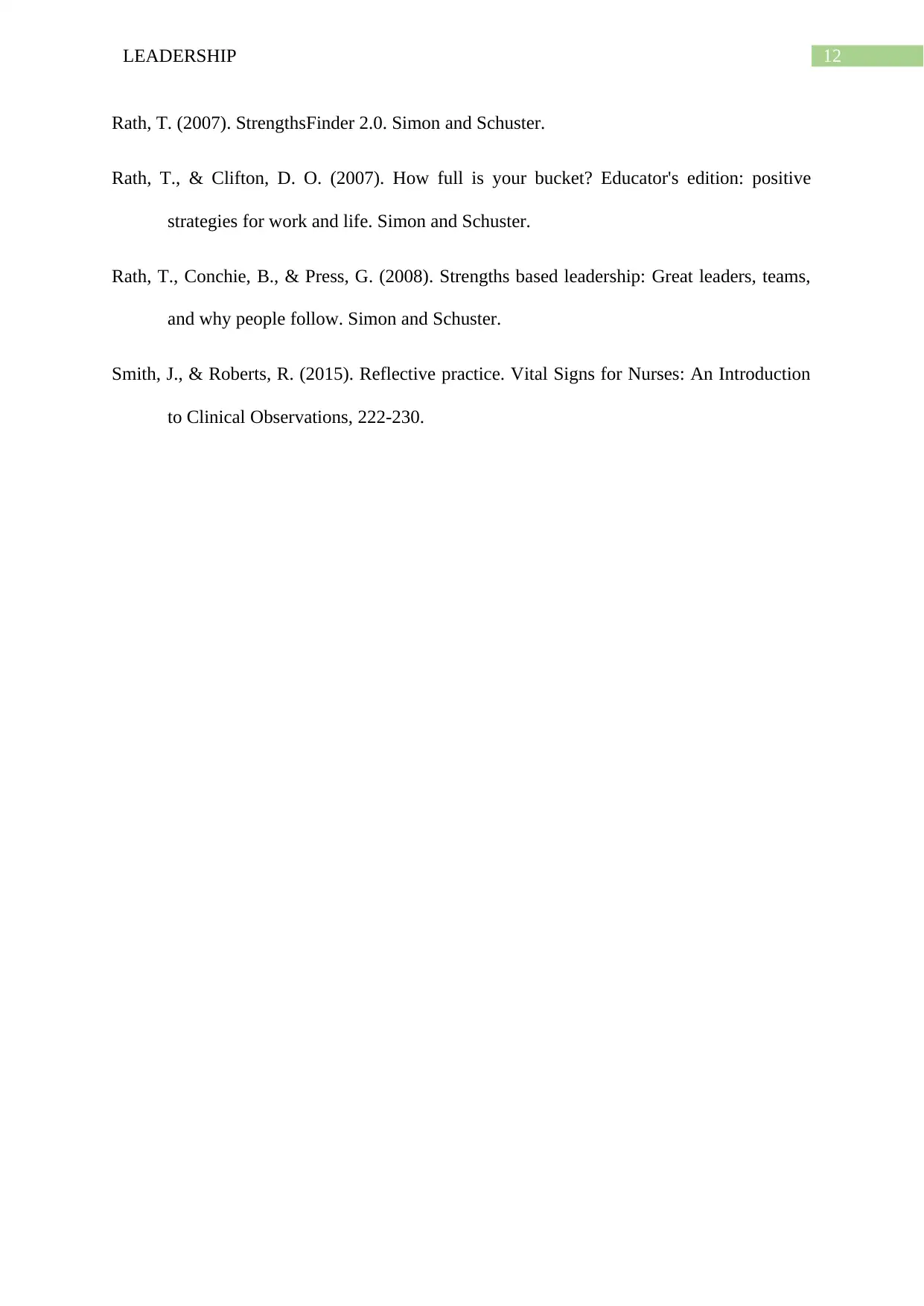
12LEADERSHIP
Rath, T. (2007). StrengthsFinder 2.0. Simon and Schuster.
Rath, T., & Clifton, D. O. (2007). How full is your bucket? Educator's edition: positive
strategies for work and life. Simon and Schuster.
Rath, T., Conchie, B., & Press, G. (2008). Strengths based leadership: Great leaders, teams,
and why people follow. Simon and Schuster.
Smith, J., & Roberts, R. (2015). Reflective practice. Vital Signs for Nurses: An Introduction
to Clinical Observations, 222-230.
Rath, T. (2007). StrengthsFinder 2.0. Simon and Schuster.
Rath, T., & Clifton, D. O. (2007). How full is your bucket? Educator's edition: positive
strategies for work and life. Simon and Schuster.
Rath, T., Conchie, B., & Press, G. (2008). Strengths based leadership: Great leaders, teams,
and why people follow. Simon and Schuster.
Smith, J., & Roberts, R. (2015). Reflective practice. Vital Signs for Nurses: An Introduction
to Clinical Observations, 222-230.
1 out of 13
Related Documents
Your All-in-One AI-Powered Toolkit for Academic Success.
+13062052269
info@desklib.com
Available 24*7 on WhatsApp / Email
![[object Object]](/_next/static/media/star-bottom.7253800d.svg)
Unlock your academic potential
© 2024 | Zucol Services PVT LTD | All rights reserved.





